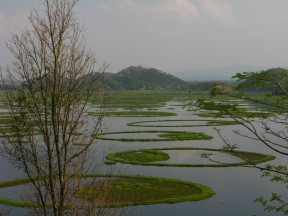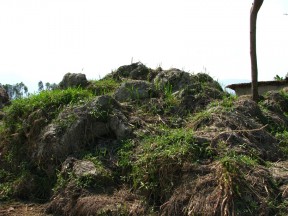Lepidocephalichthys cf. irrorata
Loktak Loach
SynonymsTop ↑
Lepidocephalus irrorata (Hora, 1921)
Classification
Cobitidae
Distribution
Currently considered to have a relatively wide distribution in the Brahamaputra River basin and has been recorded in the Muhuri and Sylhet river systems in Bangladesh plus the states of Meghalaya, Manipur and Assam in northeastern India.
Hora mentions that the species is ‘widely-distributed in lakes and streams of the Manipur Valley, India’ and that some of his specimens were obtained from Loktak Lake without providing a specific type locality.
Habitat
The majority of congeners tend to inhabit shallow, slow-moving sections of streams or calm habitats such as swamps, oxbows, backwaters and paddy fields.
These are often heavily-vegetated or littered with submerged roots, branches and leaf litter, with substrates composed of soft mud or silt.
Water clarity and depth vary on a seasonal basis across much of its range, and at certain times of year it probably enters temporarily-flooded zones. Conversely during dry periods some habitats may become stagnant with blooms of macrophytic algae and resultant hypoxia (oxygen depletion).
Under such conditions members of this genus are able to use the intestine as a supplementary breathing organ and have been observed darting to the surface to gulp atmospheric air, and some have even been recorded to survive dry periods in moist sand or mud.
Loktak lake is the largest lake in northeast India and heavily exploited for drinking water. Water quality is also declining due to eutrophication and siltation caused by inflow of nutrients, sewage, and agricultural residues.
In addition, the surrounding area has largely been deforested which has resulted in increased soil erosion and there is a major infestation of the floating plant Eichhornia crassipes, the common water hyacinth.
Much of the lake’s surface is covered by floating masses of heterogeneous soil, vegetation, and organic matter in varying states of decomposition known locally as phumdis. These are formed when small masses of undecomposed organic matter or dense growths of water hyacinth become clogged with silt, allowing colonisation by terrestrial plants.
The maximum depth of a phumdi is around 2.5 metres, with around 20% exposed to the air. When formed naturally they have important ecological roles by providing a biological sink for key nutrients and governing waterand nutrient dynamics, and when harvested the material makes an excellent bio-fertilizer.
Once they reach a certain size phumdis are often stable enough to support the building of huts or planting of crops and in Loktak several thousand people dwell permanently on them.
The largest single mass of phumdis occupies an area measuring around 40 km² and supports the last remaining population of the brown-antlered deer, Cervus eldi eldi. This area is known as Keibul Lamjao National Park, has been officially protected for several decades, and is the only floating national park in the world.
A hydroelectric barrage dam was constructed on the outflowing Imphal River in 1983, however, and this has had a major environmental impact on the lake, preventing loose phumdis from washing downriver and resulting in a proliferation of them in the lake.
In addition, phumdis have been used extensively to contsruct large (average diameter 72 metres), circular fish traps called athaphums which are now very numerous on the lake with as many as 40 in a single square kilometer in one area.
This massive proliferation of phumdis has reduced the carrying capacity of the lake ecosystem, increased siltation, and adversely affected the livelihoods of the local people who depend on it due to pollution and reducing fish stocks.
It has literally changed the nature of the lake and several fish species which used to inhabit it, such as Raiamas guttatus and Syncrossus berdmorei, have already disappeared.
Maximum Standard Length
25 – 30 mm.
Aquarium SizeTop ↑
Base dimensions of 45 ∗ 30 cm or more are required.
Maintenance
Should not prove difficult to keep but must be provided with a soft, sandy substrate since some of its time will be spent completely buried, or with only eyes protruding. When coarser gravel is used it may become stressed or damage itself trying to dig, and feeding behaviour can be inhibited.
Other décor can include water-worn rocks and driftwood branches and tree roots arranged to form plenty of hiding places and shaded spots – add these prior to the substrate to prevent them being toppled by digging activity.
Lighting can be quite dim unless you intend to grow plants and a few handfuls of leaf litter would complement the natural effect.
As this species hails from sluggish waters high flow rates are best avoided although a degree of oxygenation is recommended.
Ensure that small specimens are unable to enter filter intakes and cover the tank well as most loaches do jump at times, especially when first introduced.
Water Conditions
Temperature: 20 – 25 °C
pH: 5.5 – 7.5
Hardness: 36 – 268 ppm
Diet
Probably a micropredator sifting mouthfuls of substrate through the gills from which insect larvae, small crustaceans and suchlike are extracted.
In the aquarium it should accept sinking dried foods but should also be offered regular meals of small live and frozen fare such as Daphnia, Artemia, bloodworm, etc.
Behaviour and CompatibilityTop ↑
Lepidocephalichthys spp. are peaceful both with one another and other fishes and there exist no reports of them harming tankmates though they may prey on eggs or fry.
They fare best in the presence of conspecifics and should ideally be kept in a group of 4 or more specimens.
L. irrorata should do well alongside fishes from similar environments that occupy the upper part of the water column such as Trichopodus, Trichogaster, Trichopsis or certain Danio species.
The presence of these should also make it less timid as the absence of fishes in the upper water column is often used as a signifier for approaching danger in nature.
Sand-dwelling loaches from the families Botiidae, Cobitidae and Nemacheilidae are also suitable but proper research is essential as some can be excessively territorial or otherwise aggressive.
Sexual Dimorphism
In mature males the pectoral fins are enlarged with fused, thickened innermost (7th and 8th) rays forming a structure known as the lamina circularis.
This generally varies in form depending on species and is present in some other cobitid genera though formed by different rays.
Adult females are typically heavier-bodied and a little larger then males.
Reproduction
Unrecorded.
NotesTop ↑
This species is not traded often but may occasionally be exported as bycatch among shipments of other species.
It can be distinguished from congeners by the following combination of characters: presence of large, exposed scales on top of head; dorsal-fin origin posterior to pelvic-fin origin; moderate to small size (to 29 mm SL); caudal-fin emarginate and with dark reticulations; caudal-fin lobes with dark, elongated spots along upper and lower edges.
The family Cobitidae, often referred to as ‘true’ loaches, is widely-distributed across most of Eurasia with the Indian subcontinent, Southeast Asia and China representing particular centres of species diversity.
Phylogenetic analyses by Tang et al. (2006), Šlechtová et al. (2007) and Šlechtová et al. (2008) revealed that the group constitutes a separate genetic lineage to the family Botiidae (the two were previously grouped together under Cobitidae as subfamilies Cobitinae and Botiinae).
In the most recent study Lepidocephalichthys was not found to be as closely-related to Pangio, Lepidocephalus or Kottelatlimia as previously hypothesised though unfortunately the authors stop short of proposing an alternative theory.
All cobitids possess sharp, motile, sub-ocular spines which are normally concealed within a pouch of skin but erected when an individual is stressed, e.g. if removed from the water. Care is therefore necessary as these can become entangled in aquarium nets and with larger species even break human skin.
References
- Hora, S. L., 1921 - Records of the Indian Museum (Calcutta) v. 22 (pt 3, no. 19): 165-214
Fish and fisheries of Manipur with some observations on those of the Naga Hills. - Arunkumar, L., 2000 - Journal of Fish Biology 57(5): 1093-1104
Loaches of the genus Lepidocephalicthys (Lepidocephalichthys) from Manipur, with description of a new species. - Havird, J. C. and L. M. Page, 2010 - Copeia 2010(1): 137-159
A revision of Lepidocephalichthys (Teleostei: Cobitidae) with descriptions of two new species from Thailand, Laos, Vietnam, and Myanmar. - Kottelat, M., 2012 - Raffles Bulletin of Zoology Supplement 26: 1-199
Conspectus cobitidum: an inventory of the loaches of the world (Teleostei: Cypriniformes: Cobitoidei). - Kottelat, M. and K. K. P. Lim, 1992 - Raffles Bulletin of Zoology 40(2): 201-220
A synopsis of the Malayan species of Lepidocephalichthys, with descriptions of two new species (Teleostei: Cobitidae). - Tang, Q., H. Liu, R. Mayden and B. Xiong, 2006 - Molecular Phylogenetics and Evolution 39(2): 347-357
Comparison of evolutionary rates in the mitochondrial DNA cytochrome b gene and control region and their implications for phylogeny of the Cobitoidea (Teleostei: Cypriniformes). - Šlechtová, V., J. Bohlen and A. Perdices, 2008 - Molecular Phylogenetics and Evolution 47(2): 812-831
Molecular phylogeny of the freshwater fish family Cobitidae (Cypriniformes: Teleostei): delimitation of genera, mitochondrial introgression and evolution of sexual dimorphism. - Šlechtová, V., J. Bohlen and H. H. Tan, 2007 - Molecular Phylogenetics and Evolution 44(3): 1358-1365
Families of Cobitoidea (Teleostei; Cypriniformes) as revealed from nuclear genetic data and the position of the mysterious genera Barbucca, Psilorhynchus, Serpenticobitis and Vaillantella.





